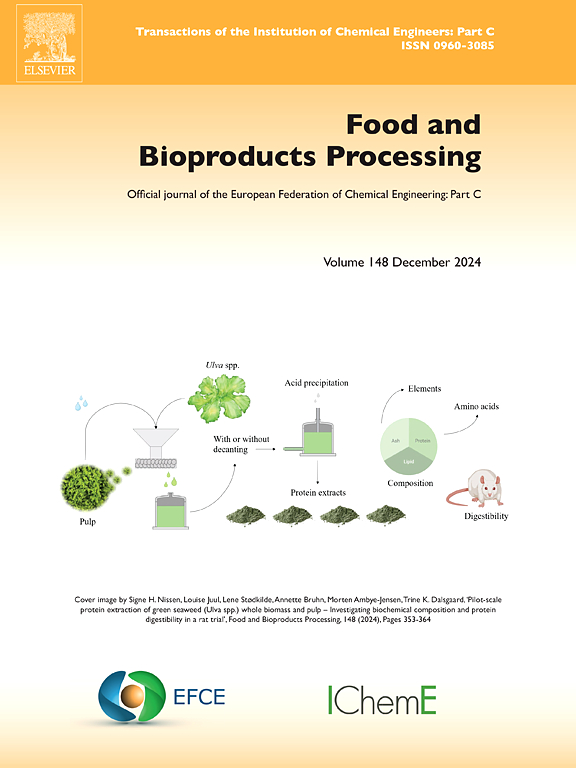用静态混合器优化连续流微波加工以提高加热均匀性
IF 3.5
2区 农林科学
Q2 BIOTECHNOLOGY & APPLIED MICROBIOLOGY
引用次数: 0
摘要
本研究解决了在高粘性液态食品的连续流微波加工中加热不均匀的问题,这是一个常见的问题,导致食品中形成热点和冷点,导致产品质量下降。对于粘性流体来说,不均匀加热尤其成问题,因为它们的低粘度阻碍了传热。本研究的目的是研究Kenics静态混合器的使用-一种由逆时针和顺时针交替扭曲的螺旋元件组成的装置-旨在改善此类系统中的热量混合和提高温度均匀性。Kenics混合器特别适用于处理高粘性流体,其中有效的混合对于实现均匀的温度分布至关重要。为了评价Kenics静态混合器的性能,建立了装有Kenics混合器的连续流微波处理系统的数值模型。该模型采用有限元方法模拟了系统内的流体流动、传热和电场分布。以温度均匀性(以出口流体温度变化系数量化)为目标函数,采用遗传算法对系统进行优化。本研究探讨了两种Kenics混合器配置:R-L和R-R,并考察了Kenics混合器设计(展弦比、厚度、Kenics混合器之间的间隙和Kenics混合器的数量)和流体速度对流体出口温度均匀性的影响。结果表明,与空心管相比,R-L和R-R结构的出口温度均匀性分别提高了71.04 %和72.09 %。R-R配置还在不牺牲流体出口温度均匀性的情况下获得了更高的平均出口温度。在Kenics混合器中使用损耗材料降低了流体出口的温度均匀性,同时提高了两种配置的平均流体出口温度。研究表明,采用Kenics静态混合器可以显著降低连续流微波加工中的加热不均匀性,提高粘性流体食品加工系统的效率和可扩展性。本文章由计算机程序翻译,如有差异,请以英文原文为准。
Optimization of continuous-flow microwave processing with static mixers for enhanced heating uniformity
This study addresses the challenge of non-uniform heating in continuous-flow microwave processing of highly viscous liquid foods, a common issue that leads to the formation of hot and cold spots in the food product, leading to reduced product quality. Non-uniform heating is especially problematic for viscous fluids due to their low viscosity, which hinders heat transfer. The objective of this study is to investigate the use of a Kenics static mixer – a device consisting of alternating counterclockwise and clockwise twisted helical elements – designed to improve heat mixing and enhance temperature uniformity in such systems. The Kenics mixer is particularly suitable for handling highly viscous fluids, where effective mixing is critical for achieving uniform temperature profiles. To evaluate the performance of the Kenics static mixer, a numerical model of the continuous-flow microwave processing system equipped with Kenics mixer was developed. The model simulates fluid flow, heat transfer, and electric field distribution within the system using the finite element method. A genetic algorithm was used to optimize the system, with temperature uniformity (quantified by the coefficient of variation in fluid temperature at the outlet) as the objective function. The study explores two Kenics mixer configurations: R-L and R-R, and examines the effects of Kenics mixer design (aspect ratio, thickness, gap between Kenics mixers, and number of Kenics mixers) and fluid velocity on temperature uniformity at the fluid outlet. The results show a 71.04 % and 72.09 % improvement in temperature uniformity at the fluid outlet for the R-L and R-R configurations, respectively, compared to that of a hollow pipe. The R-R configuration also achieved a higher mean outlet temperature without sacrificing temperature uniformity at the fluid outlet. Using lossy materials for Kenics mixer reduces the temperature uniformity at the fluid outlet while increasing mean fluid outlet temperature for both configurations. The study concludes that incorporating the Kenics static mixer can significantly reduce non-uniform heating in continuous-flow microwave processing, enhancing the efficiency and scalability of food processing systems for viscous fluids.
求助全文
通过发布文献求助,成功后即可免费获取论文全文。
去求助
来源期刊

Food and Bioproducts Processing
工程技术-工程:化工
CiteScore
9.70
自引率
4.30%
发文量
115
审稿时长
24 days
期刊介绍:
Official Journal of the European Federation of Chemical Engineering:
Part C
FBP aims to be the principal international journal for publication of high quality, original papers in the branches of engineering and science dedicated to the safe processing of biological products. It is the only journal to exploit the synergy between biotechnology, bioprocessing and food engineering.
Papers showing how research results can be used in engineering design, and accounts of experimental or theoretical research work bringing new perspectives to established principles, highlighting unsolved problems or indicating directions for future research, are particularly welcome. Contributions that deal with new developments in equipment or processes and that can be given quantitative expression are encouraged. The journal is especially interested in papers that extend the boundaries of food and bioproducts processing.
The journal has a strong emphasis on the interface between engineering and food or bioproducts. Papers that are not likely to be published are those:
• Primarily concerned with food formulation
• That use experimental design techniques to obtain response surfaces but gain little insight from them
• That are empirical and ignore established mechanistic models, e.g., empirical drying curves
• That are primarily concerned about sensory evaluation and colour
• Concern the extraction, encapsulation and/or antioxidant activity of a specific biological material without providing insight that could be applied to a similar but different material,
• Containing only chemical analyses of biological materials.
 求助内容:
求助内容: 应助结果提醒方式:
应助结果提醒方式:


